StoryBrand Framework: Clarify Your Message So Customers Will Listen
Life is complex, isn’t it? Stories help simplify it. The good ones stay with us because they touch us emotionally and deeply. You won’t remember a list of facts, but you’ll remember how a story made you feel. We love stories (and films) because they let us be part of an experience – we feel connected. We don’t just like stories. We need them. To learn. To feel. To connect. To survive.

Hey my lovely readers, today’s blog is all about story, and how story can transform your brand for the better.
First, I want to thank you for the love and appreciation you showed on my previous posts (like The Brand Gap and Zag by Marty Neumeier).
Your support keeps me writing such valuable content. So grab a cup of coffee and a notebook, because by the end of this blog, you’ll have the foundation of a solid story for your brand that you can start using right away.
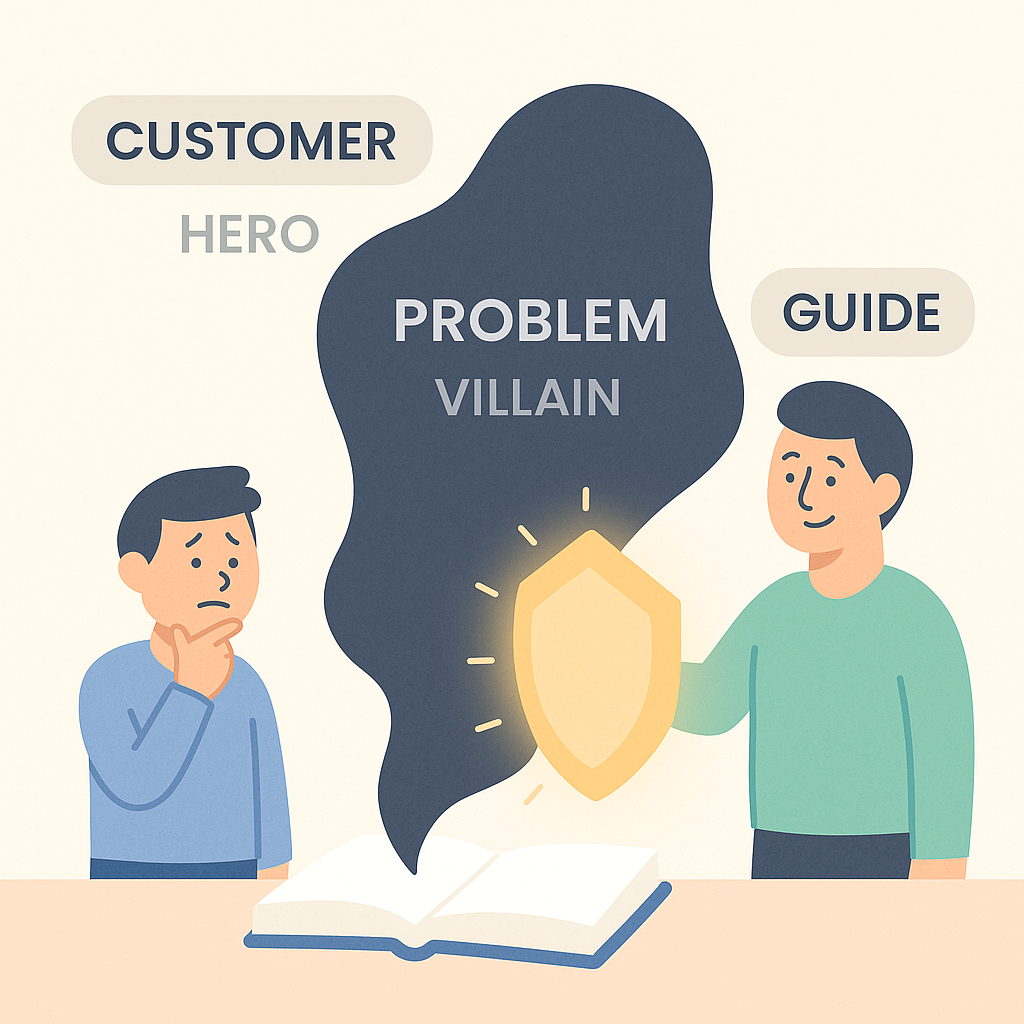
The Key to Being Seen, Heard, and Understood
When it comes to marketing and branding, stories are a powerful weapon – one you can use to defeat the “villains” (your customers’ problems) and transform the hero (your customer). Let me ask a simple question: Does your business/brand have a story that your audience can truly feel and connect with? If not, it’s time to craft one.
According to Donald Miller (author of Building a StoryBrand), most brands fail because they don’t have a great story. Or, they have a story but make themselves the hero of it, instead of making the customer the hero.
One line I love from his book is: “Your customer is the hero, not your brand.”
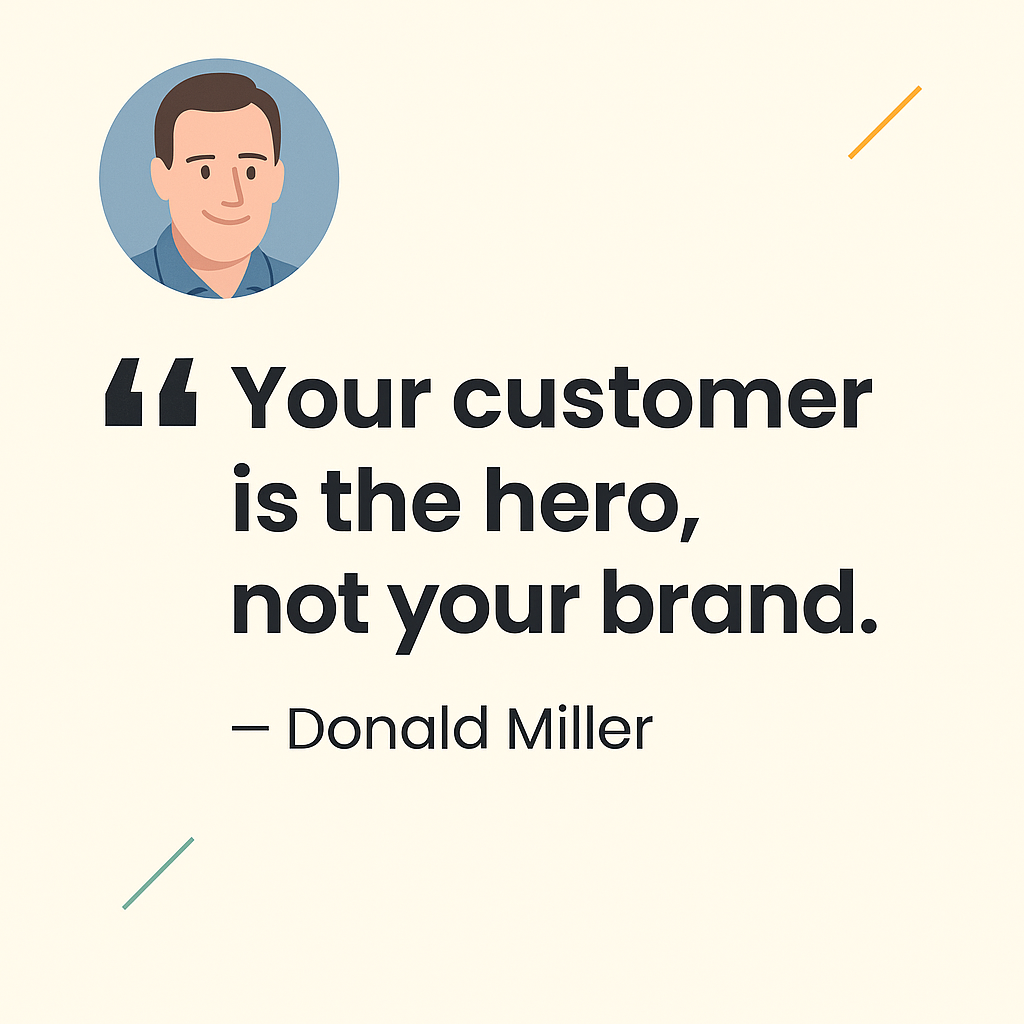
If you’re an entrepreneur, freelancer, or whatever you do – think about it. When sending proposals or selling a product, if the story only revolves around you (the brand), chances are you’ll fail drastically. It’s human nature: people want their own problems addressed first.
Miller observes that many companies waste lots of money on marketing that yields no results, simply because their story is unclear. To sell effectively, you have to clearly craft your message. If you don’t invest in clarifying your story, the only thing your customers will hear is noise.
Countless business owners have spent tens of thousands on web design and ads only to see no results. Why? Because, as Miller emphasizes, pretty websites don’t sell – words (clear messages) sell. (Of course, that doesn’t mean your website should be ugly either! It means that design and message must work together, with message being crystal clear.)
In business, it’s a rule that you should improve every aspect you can – from building the product to distributing it, from selling to satisfying your customer. But none of that matters if people don’t understand your offer. No one is going to listen to you if your message isn’t clear, no matter how fancy your marketing materials are.
Donald Miller has worked with companies from small startups to billion-dollar enterprises, and he notes that the StoryBrand framework can apply to any industry. In the end, the human brain – no matter the region or culture – is drawn toward clarity and away from confusion.
Even if you have the best-quality product in the marketplace, you’ll lose to an inferior product if your competitor’s offer is communicated more clearly. The simpler and clearer the communication, the easier it is for the brain to digest.
The end user cares about their own survival and well-being; they’re not interested in how big your manufacturing plant is or how many awards you have.
Two big mistakes many brands make initially:
They fail to focus on the aspect of their offer that will help people survive and thrive. (Great stories zero in on customers’ survival needs – physical, emotional, relational, and even spiritual.)
They make people burn too many mental calories trying to understand their offer. (When faced with information overload, people tune out to conserve energy.)
In short, your offer should help people survive or thrive in a way they can understand without burning too many calories.
Stories: The Most Powerful Weapon to Grow Your Business
Stories are atomic – they contain enormous energy that can’t be measured mathematically. Just like atomic energy can power a city, story is one thing that can hold a human being’s attention for hours.
Neuroscientists claim that the average human spends about 30% of their day daydreaming – except when they’re engaged by a story. When we read, listen to, or watch a story, the story “does the daydreaming” for us, keeping us glued.
Story is the greatest weapon we have to cut through noise, because it arranges information in a way that compels us to listen.
Our brains are wired to remember music, not noise – and the same is true for brands. The mind holds onto brands that strike a clear note and forgets those that just add to the chaos. When a storyteller bombards people with too much info, the audience is forced to burn too many calories to understand it. The lesson? Keep it clear and keep it concise.
At its core, branding is about creating simple, relevant messages we can repeat over and over until we “brand” ourselves into public consciousness.
Steve Jobs & Apple: A Two-Word Story
Apple’s iconic “Think different” campaign distilled a complex message into just two words, using striking imagery and no jargon.
Steve Jobs was a genius at crafting stories. When he returned to Apple, after spending time around professional storytellers at Pixar, he came to a powerful realization: story is everything.
In his first campaign back, Apple’s marketing team had prepared a nine-page ad to run in The New York Times, filled with technical details. Jobs slashed it down to just two iconic words:
Think Different.
There were no computers in the ads. No technical jargon. No noise. Just those words and images of great visionaries.
Meditate on those two words for a moment. What story are they telling? It’s not about the Apple brand at all — it’s about you. You are the hero in that story; Apple positions itself as the guide that empowers your greatness.
This is why that campaign was so effective. Jobs realized people don’t buy the best products; they buy the ones they understand the fastest. Think Different spoke to customers’ identity and aspirations in a flash of clarity.
Remember this: people are in a hurry. They won’t spend time trying to figure out a muddled message. As Miller puts it, “If you confuse, you lose.” Clarity isn’t optional – it’s the foundation of every high-converting campaign.
In every line of copy we write, we are either contributing to the customer’s story or descending into confusion. We are either making music or making noise – and nobody remembers a brand that’s just making noise.
One practical test from Building a StoryBrand is the Grunt Test. The idea is simple: within 5 seconds of looking at your website or marketing material, a visitor (even a caveman, figuratively speaking) should be able to answer three questions:
What do you offer?
How will it make my life better?
What do I need to do to get it?
If a stranger can’t identify those things in a few seconds – grunt in recognition – your message is too complex. Our companies may be complex, no doubt. That’s exactly why we need a clear messaging filter: to strip away everything that bores or confuses our customers and spotlight only the parts of our brand that help them survive and thrive.
When we do this well, we stop being just another business and start becoming the guide who helps customers overcome real challenges and step into the life they’ve been dreaming of.
The framework in Miller’s book is both simple and powerful. By the time you’re done applying it, your entire brand message will be so clear it could fit on a single sheet of paper. And when your customers finally understand how you fit into their story – how you can help them live a better, more meaningful life – your company will grow.
To help you get there, let’s unpack one of the most powerful storytelling frameworks you can use to shape your brand message with clarity and emotional resonance.
The StoryBrand Framework: Your Customer as Hero
Donald Miller’s StoryBrand framework is a 7-part structure that positions your customer as the hero and your brand as the guide. It goes like this:
- A Character – (the customer) has a want or goal.
- Has a Problem – that creates external, internal, and philosophical struggles.
- Meets a Guide – (you, the brand) who shows empathy and authority.
- Who Gives Them a Plan – a clear path or solution.
- And Calls Them to Action – a direct or transitional call to act.
- That Helps Them Avoid Failure – positioning your product as the solution to avoid a bad outcome.
- And Ends in Success – painting a picture of the positive ending.
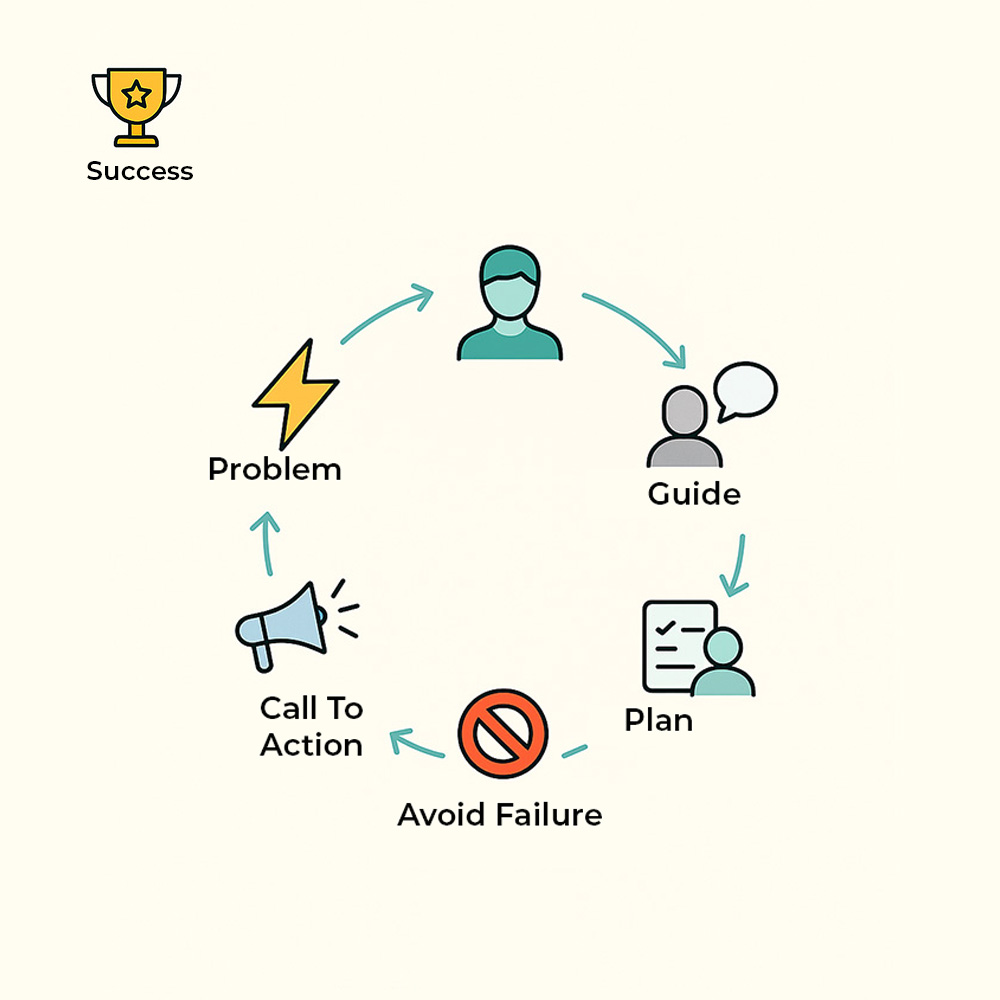
Use this framework to clarify your positioning and speak directly to your audience’s needs. Now, let’s dive into each part of the framework in depth.
1. A Character (The Hero)
The customer is the hero, not your brand. This is the cornerstone of StoryBrand. When we position our customers as the hero and ourselves as the guide, we become a trusted resource to help them overcome their challenges. It’s not just polite – it’s good business.
As a brand, it’s crucial to define something your customer wants. The moment you identify a specific want or goal your customer has, you open what’s called a story gap in their mind: a question that needs resolution.
Essentially, the customer subconsciously asks, “Can this brand really help me get what I want?” If you communicate clearly that you understand their desire and can help achieve it, you not only gain their interest but also begin to build trust.
In many cases, clearly defining a customer’s want – and showing you can fulfill it – is the first step to conversion.
For example, consider how these simple statements define what the customer wants, creating instant clarity and intrigue:
- Financial Advisor: “A plan for your retirement.”
- Fine Dining Restaurant: “A meal everyone will remember.”
- Real Estate Agent: “The home you’ve dreamed about.”
- Bookstore: “A story to get lost in.”
- Breakfast Bars: “A healthy start to your day.”
Each of the above focuses on one overarching desire of the customer. As soon as you read “a plan for your retirement,” you as the customer start thinking: Do I have such a plan? I do want a secure retirement… could this advisor help me get it? The story gap opens.
Open a Story Gap in Your Customer’s Mind
You should intentionally open a story gap between your hero (customer) and what they want. The tension created by the gap between where they are and where they want to be is a magnetic force that drives human behavior. In story terms, it’s what keeps us turning pages.
Most actions people take in life can be explained by one simple pattern: a story gap opens, and they act to close it. Whether it’s buying a product, chasing a goal, or making a decision, humans are driven by the urge to resolve the gap between where they are and where they want to be.
If we don’t clearly define something our customer wants, we miss the chance to create this dynamic tension in their mind. Without a defined want, there’s no open loop, no curiosity, nothing pulling them toward our brand. But when we identify a specific desire and place it front and center in our messaging, we trigger a story gap that demands resolution. That’s what motivates people to engage.
Keep Your Customer’s Ambition Focused
One critical mistake organizations make is trying to list too many things the customer might want. It’s understandable – if your product or service can solve multiple problems, you feel you should mention them all. But the market doesn’t reward complexity; it rewards clarity. At the highest level, your challenge is this: define one simple, relevant thing your customer truly wants. Then become known as the brand that delivers on that promise every single time.
Tie It to a Survival Desire
Once you’ve defined what your customer wants, take it one step deeper. Don’t just connect it to a superficial benefit – connect it to a fundamental human survival desire.
People are drawn to stories that help them survive and thrive. Now, “survival” in modern terms isn’t just about food and shelter; it’s about things like social standing, confidence, security, and meaning in life.
For instance, the author Donald Miller shares a story of a friend whose ad campaign initially flopped. The friend’s original tagline was “Inhale Knowledge, Exhale Success.” Poetic, perhaps, but it didn’t land with customers.
They later changed it to: “Helping you become everyone’s favorite leader.” Why did the new tagline work so much better? Because it taps into primal human drives. Being a “favorite leader” implies greater respect, stronger social bonds, and more career opportunities – in other words, higher chances of survival and success in a social sense. It subconsciously promised benefits like status and acceptance that people deeply crave.
Here’s the key insight: whenever possible, frame what you offer in terms of basic survival instincts or core human needs. Think about what “survival” means for your audience. At our core, we all want to be safe, healthy, happy, and strong.
In today’s world, survival can mean having the financial, emotional, and social resources to live well – to eat and drink well, connect with others, reproduce, achieve status, and protect ourselves from threats.
Consider which of these fundamental desires your business touches on, and highlight those. Some common survival-related wants include:
- Conserving financial resources (saving or making money)
- Conserving time and energy (efficiency, convenience)
- Building social networks and relationships (belonging, community)
- Gaining status or recognition (respect, prestige)
- Accumulating resources or knowledge (tools, information that confer advantage)
- The innate desire to be generous (feeling useful, giving to others)
- The desire for meaning or purpose (a sense of mission or higher calling)
When Miller gave his coach friend the new tagline (“Helping you become a leader everybody loves”), the audience’s brains instantly translated that message into multiple survival benefits: greater social connection, higher status, a chance to be generous (as a loved leader helps others), access to more opportunities, and even a deeper sense of meaning.
All that from one clear line! That’s what a clear, emotionally aligned message can do – it speaks to what people truly want beneath the surface.
In business, if we don’t communicate clearly, we don’t just confuse people, we lose them (or as Miller says, we shrink). Your brand should act like a guide promising a clear destination.
Every potential customer should immediately know where you’re aiming to take them and why it matters.
So ask yourself: What core desire does my customer have that my brand can fulfill? Start there. Because when your message hits the heart, your brand’s growth isn’t far behind.
2. Has a Problem (The Villain)
Every hero has a problem to solve – that’s what makes a story interesting. In business, that problem usually has multiple layers. Most companies focus on solving external problems (a product that saves time, increases productivity, etc.).
But customers are actually looking for relief from their internal struggles – the frustration, confusion, or self-doubt that external problem causes inside them. In fact, identifying your customer’s internal problem is the key to entering their story, because it’s the internal struggle that gives the journey emotional weight.
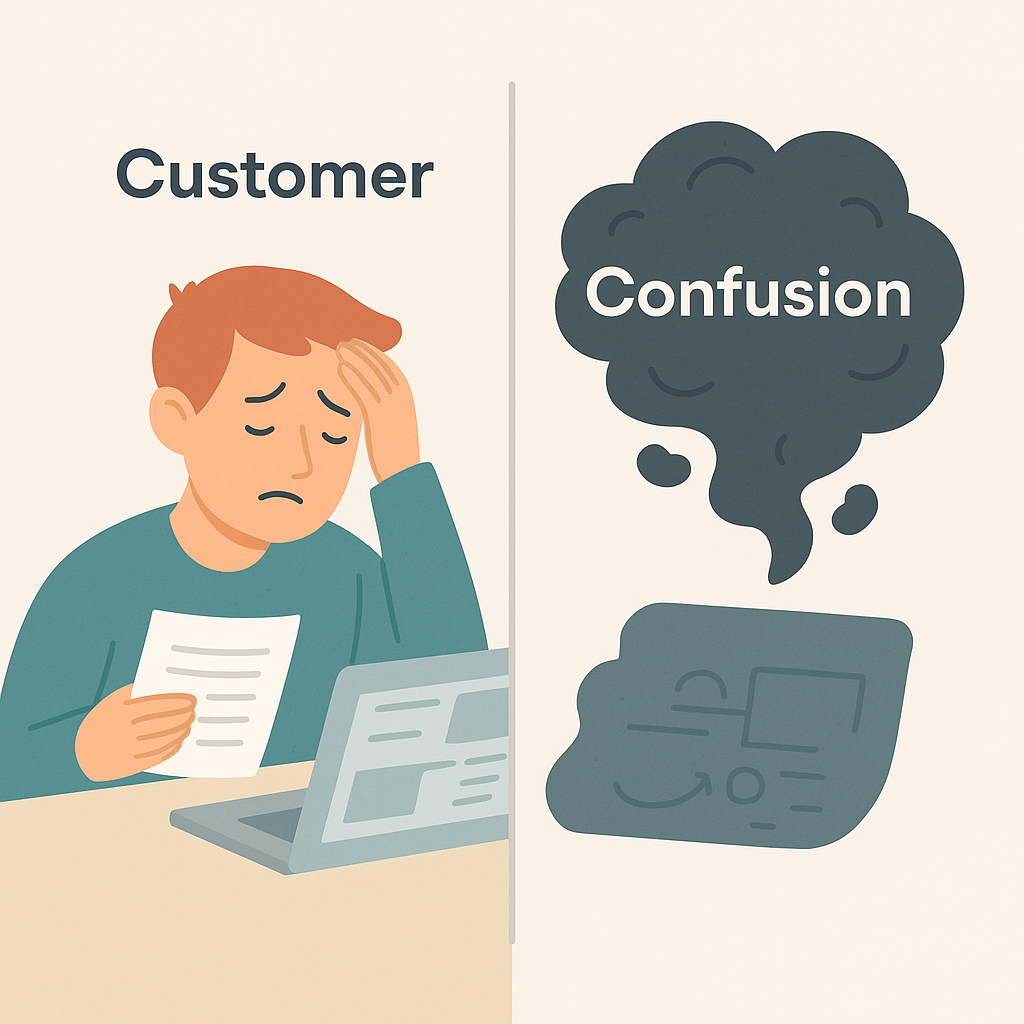
Once you’ve invited them into a story by acknowledging what they want, how do you keep their attention? By proving you understand their pain. When you clearly name the problems your customers face, you position yourself as a brand that “gets it.” You’re no longer just selling; you’re empathizing and guiding.
The problem, in many ways, is the hook of every compelling story. If we don’t name the villain or conflict, the story falls flat. The more we talk about the real problems our customers experience – especially the ones they feel deeply but can’t always articulate – the more they’ll trust us and be interested in our solution.
Every Story Needs a Villain
Think of your customer’s problem as a villain in the story. Every great tale has a villain because the villain gives the conflict a clear focus – a force the hero must overcome.
And here’s a storytelling secret: the more clearly you define the villain (and the more “evil” or threatening it is), the more sympathy and support the audience gives the hero. We root for heroes who face formidable villains. This tension keeps people engaged.
In business storytelling, framing the problem as a villain can be incredibly effective. If you want your customers to pay attention when you describe your product or service, cast that product as a weapon they can use to defeat a villain in their life.
Make the villain tangible and personal. It doesn’t have to be a person; it could be an abstract foe like confusion, inefficiency, fear, or inconvenience – but you should personify it with traits and intent. It should feel like something actively working against your customer’s success.
For example, suppose you sell time management software. You could simply list features… or you could villainize “distractions” and “busywork.” Paint distractions as sneaky thieves that steal your focus, your family time, your peace of mind – and cost you hours of productivity (maybe even money).
Suddenly, your software isn’t just an app; it’s the sword and shield that helps the hero (your customer) slay the dragon of distraction. The story shifts from “buy our tool” to “join the battle.” The customer becomes the hero in an epic struggle, and your brand is the wise guide equipping them with what they need to win.
Advertisers often personify the problems their customers face in order to spark imagination and give frustration a focal point. It might sound dramatic, but it works because it taps into emotion. Nobody is motivated by a lukewarm problem. But an urgent, villainous problem? That gets attention.
Characteristics of a Good “Villain”
Not all villains are created equal. In a business context, here’s how to craft a villain that dramatically increases engagement:
- Represents a Core Problem: The villain should embody the root cause of your customer’s pain, not just a minor symptom. For instance, “decision fatigue” or “information overload” as a villain is more compelling than just “too many emails.” It’s the silent assassin draining their focus.
- Relatable and Recognizable: Your audience should immediately recognize this villain in their own life. It should feel personal and familiar. Think “the 3:00 p.m. energy crash” or “the endless meeting that could have been an email.” When they hear it, they nod and think, Yes, that’s exactly what I struggle with!
- Singular and Focused: Don’t present a whole rogues’ gallery. Zero in on one clear villain – the primary antagonist. A scattered, vague set of enemies will weaken the story. Identify the one threat that causes the majority of their woes (e.g. “scope creep” for project managers, or “toxic sugar” for a health coach).
- Personified Traits: Even if your villain is abstract, give it characteristics like it’s a character. Maybe “The Overwhelm” that sneaks up when you open your email in the morning, or “The Procrastinator” lurking every time you sit down to work. This isn’t about literal demons; it’s about creating a mental image that your customer can fight. A named villain with a face (even an imaginary face) is far more engaging than an unnamed menace.
By defining the villain clearly, you’re not fear-mongering; you’re showing customers you understand the stakes and you’re on their side against a common enemy.
The 3 Levels of Customer Problems
A truly compelling brand story addresses problems on three levels: external, internal, and philosophical. Let’s break these down:
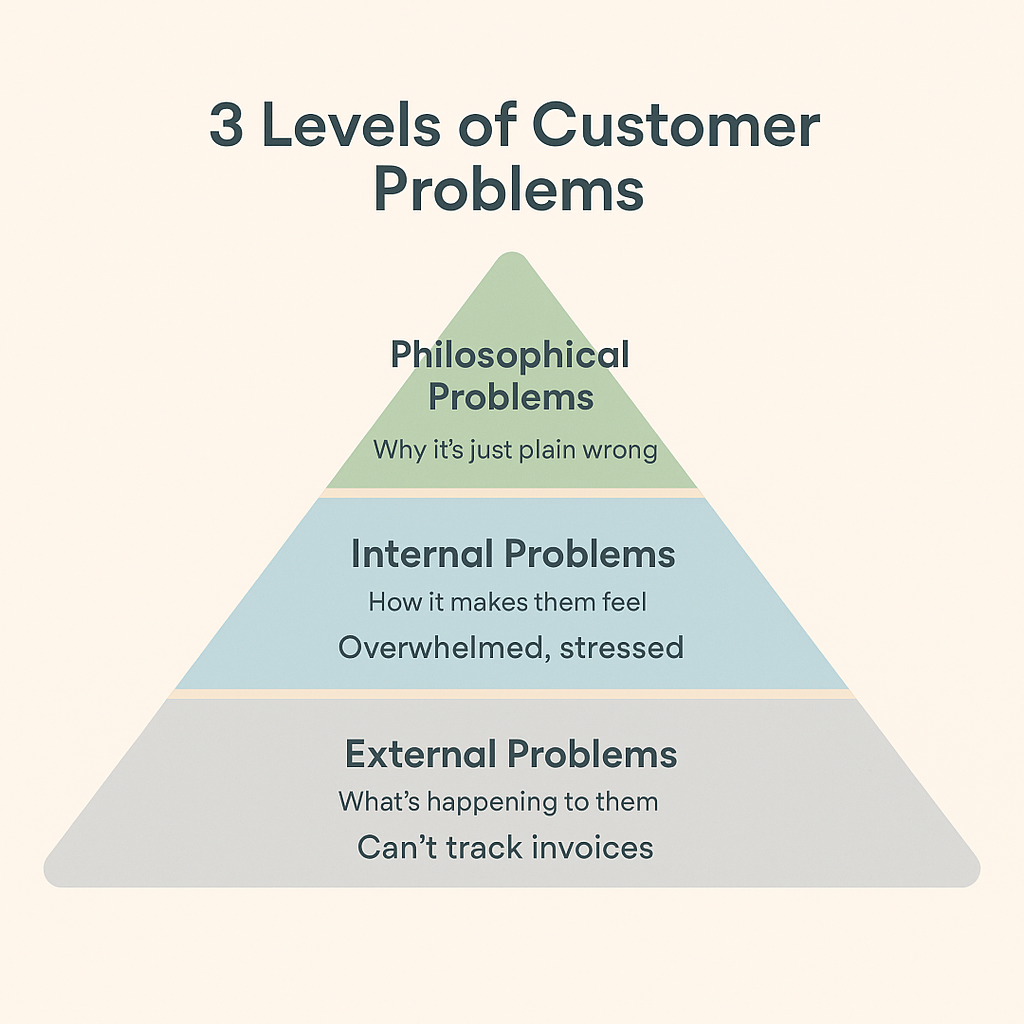
- External Problems – The obvious obstacle.
These are the concrete, surface-level challenges your product or service helps with. It’s usually what your company does. Often it’s stated as a straightforward need: “My website takes too long to load.” “I’m not getting enough leads.” “I don’t have a system to manage my tasks.” Most marketing stops here, pitching solutions to these external issues. External problems are essential to mention (customers do have practical needs), but by themselves they don’t create an emotional connection. - Internal Problems – The emotional struggle.
Beneath every external problem is frustration or pain it causes internally. This is where loyalty is won. How does that external issue make your customer feel? Incompetent, overwhelmed, anxious, left out, unsafe? For example: “I feel like I’m falling behind,” might be the internal fear beneath “not enough leads.” “I’m overwhelmed and don’t know where to start,” might be under “no system to manage tasks.” “I’m tired of doing everything on my own,” could underlie a lack of support or tools. Customers want relief from these feelings. When you speak to the internal problem, you demonstrate empathy. You’re saying, “I understand how you feel, and you’re not alone.” This builds a trust connection. - Philosophical Problems – The why it matters.
This is the deepest level: Is there a larger idea of right and wrong at play? It’s where you address the sense of injustice or the principle that’s being violated. It’s tapping into values. For instance: “Time is precious and shouldn’t be wasted on inefficient systems.” Or, “Small businesses deserve the same tools that big companies have.” Or, “Everyone should have access to education, no matter their background.” These statements elevate the conversation. They invite people to join a cause, not just buy a product. When you articulate the philosophical problem, you show that your brand stands for something. It gives customers a higher purpose to rally behind, which can create devotion beyond reason. (Think of brands that people almost fanatically support – they usually stand for an ideal, not just a product.)
Framing your product or service as the solution to an external problem, that resolves the internal feelings, while aligning with a philosophical truth, instantly elevates its value in the eyes of customers. When you hit all three levels, people feel an emotional and logical satisfaction. They think, “Yes, this will fix my issue, it feels like they understand me, and it’s the right thing to do.” That’s a powerful combination.
Consider an example to tie it together: Imagine a company selling eco-friendly home insulation. The external problem: high energy bills and a drafty house. Internal problem: the homeowner feels worried and guilty about wasting money and energy.
Philosophical problem: we have a responsibility to protect the planet for future generations. A message addressing all three might be: “Keep your home cozy and your bills low (external), so you can relax without worry (internal) – and together, let’s conserve energy for a greener world (philosophical).” In one narrative, you’ve covered the practical, the emotional, and the idealistic reasons to buy.
Recap tip: If you’re ever unsure whether your message is resonating, check if you’ve addressed all three layers of the problem. It can reveal gaps in your storytelling.
Brainstorm: Identify Your Customer’s “Villains”
To apply this to your brand, ask yourself:
- What singular villain does my brand promise to help customers defeat? (What’s the chief source of pain or frustration?)
- What external, tangible problem does that villain cause for my customer? (The practical issue you solve.)
- How does that problem make my customer feel? (The internal problem – fear, frustration, inadequacy, etc.)
- Why is it unjust that people should have to suffer this villain? (The philosophical angle – insert your values here.)
Jot down answers to those and you’ll have the raw material to craft a compelling story about the problem and why it matters.
3. And Meets a Guide (Your Brand)
Here’s a fundamental truth in both life and storytelling: heroes need guides. Luke Skywalker had Obi-Wan, Frodo had Gandalf, Katniss had Haymitch. Likewise, your customer – the hero – needs you as their guide.
One of Miller’s key points is: “Customers are not looking for another hero; they are looking for a guide.” Remember, your customer wakes up each day as the hero of their own story. They have goals, they face challenges (external, internal, philosophical as we discussed), and deep down they know they could use some help.
What they are not looking for is someone to upstage them or lecture them about how great your brand is. They don’t want a hero to rescue them without their involvement; they want a guide who equips them to rescue themselves.
If a brand positions itself as the hero (“We’re the greatest! We’re the center of the story!”), it actually competes with the customer’s own identity as the hero – and that’s confusing and off-putting.
Customers will simply move on, because the story doesn’t feel like it’s about them. The spotlight must remain on the hero (customer) and their journey. Your job is to illuminate the path, not to steal the spotlight.
So how do you position yourself as the guide effectively? Two key traits:
- Empathy: Show that you understand exactly what the hero is feeling and facing. You “get” their problem. Empathy is communicated by acknowledging fears and frustrations in your messaging. Phrases like “We know how overwhelming planning a wedding can be” or “Tired of feeling like you’re doing it all alone?” signal empathy. It builds a bond of trust. The customer thinks, “This brand understands me.” They start to see you as an ally, not just a vendor.
- Authority: While empathy gets you trust, authority earns you respect. To be a credible guide, you have to demonstrate you have the chops to help the hero win the day. This can be done by showcasing testimonials (“Here’s what our successful clients say”), displaying your credentials or years of experience, mentioning awards, or logos of well-known customers you’ve served. Authority can also come through confident, competent communication – for instance, offering specific insights or a clear plan (next section) that makes it obvious you know your stuff. The message is, “I have helped others like you, and I can help you too.”
A balance of humility (empathy) and competence (authority) is the sweet spot. Too much bragging (authority without empathy) and you sound like a know-it-all that doesn’t care.
Too much empathy without proof (all heart, no solutions) and people may like you but doubt you can deliver. As a guide, you want to convey: “I care about your problem, and I have a way to help you overcome it.”
4. Who Gives Them a Plan (The Path Forward)
A hero trusts a guide who has a plan. After all, if you’ve convinced the customer you understand their problem and have helped others, the next thing they wonder is: “Okay, so how will you help me? What do I need to do?” This is where you lay out a simple plan of action.
Remember our mantra: “If you confuse, you lose.” Lack of a clear plan is a common source of confusion. Even if someone is interested in what you offer, if they can’t easily see how to engage or how it works, they may hesitate and drift away. Your job is to remove all doubt and provide a clear path to success.
Crafting a plan in your messaging doesn’t mean you have to explain every detail of your process. In fact, you shouldn’t – too much information can overwhelm and turn off prospective customers. Studies have shown that when you give people too many choices or a firehose of details, their likelihood of buying actually decreases. So, think high-level steps. Three, maybe four steps at most, that a fifth-grader could understand.
A good plan answers the question: “What do I need to do next, and how will it work?” It outlines how the hero can move forward with the guide’s help. There are generally two types of plans you might include:
- Process Plan: A brief step-by-step of how someone goes from start to finish with you. (This alleviates fear by making the unknown journey feel known.) For example: “1) Schedule a consultation. 2) We design your custom plan. 3) You achieve your goals.” It’s that basic.
- Agreement Plan: A list of commitments or assurances that remove perceived risks. For example, “Our 3-part Guarantee: You’ll get X result, Y level of support, and Z refund if unsatisfied.” This type of plan addresses fears like “What if it doesn’t work?” by proactively saying, “Here’s our plan if things go wrong.”
Let’s illustrate a simple process plan. Suppose you sell an online course that helps small business owners grow on Instagram. You could plan it out like:
Plan: “First, we help you set up a professional-looking profile that attracts your ideal audience. Next, we teach you a content strategy so you know exactly what to post and when. Finally, we show you how to turn those followers into paying customers through proven engagement tactics.”
See how concrete that is? Immediately, a potential customer can picture the path to success: profile -> content -> conversion. It’s not vague (“we’ll improve your Instagram”). It’s clear and sequential. This builds confidence. It also subtly shows both empathy (“we know you’re struggling with what to post or how to convert followers”) and authority (“we have a step-by-step method”).
Your plan should also be easy to remember and repeat. If it can fit in one short paragraph or a few bullet points, you’re on the right track. Ideally, it should have no more than around 3 steps (4 at most), unless you’re in a very complex industry where maybe a few more are needed (and even then, you’d group them into phases).
A quick tip: Try to start each step with a verb and make it optimistic. E.g., “Schedule a Call,” “Get a Personalized Plan,” “Reach Your Goals.” This keeps it action-oriented and focused on the positive outcome.
By giving a clear plan, you’re doing something psychologically important: you’re reducing the risk and uncertainty in your customer’s mind. You’re saying “I know you’re wondering how to start or whether this will work – here’s exactly how we’ll do it.” That clarity can be the difference between someone clicking “Buy Now” or bouncing off your page.
5. And Calls Them to Action (The Ask)
Even with everything set up – the hero (customer) knows what they want, the villain/problem is identified, the guide (you) is trusted, and the plan is clear – nothing happens until the hero is called to action.
In stories, the hero often needs a push. Frodo needed Gandalf to urge him to take the ring to Mordor. Neo needed Morpheus to offer him the red pill. Likewise, customers often need you to challenge or invite them to take the next step.
Simply put, customers do not take action unless they are challenged to take action. We might wish that people would just magically know what to do and do it, but the reality is we all procrastinate or avoid decisions – especially when they involve spending money or effort.
So you must clearly and boldly ask for the sale (or the sign-up, or whatever your direct conversion is), and/or invite them into a smaller step that starts the journey.
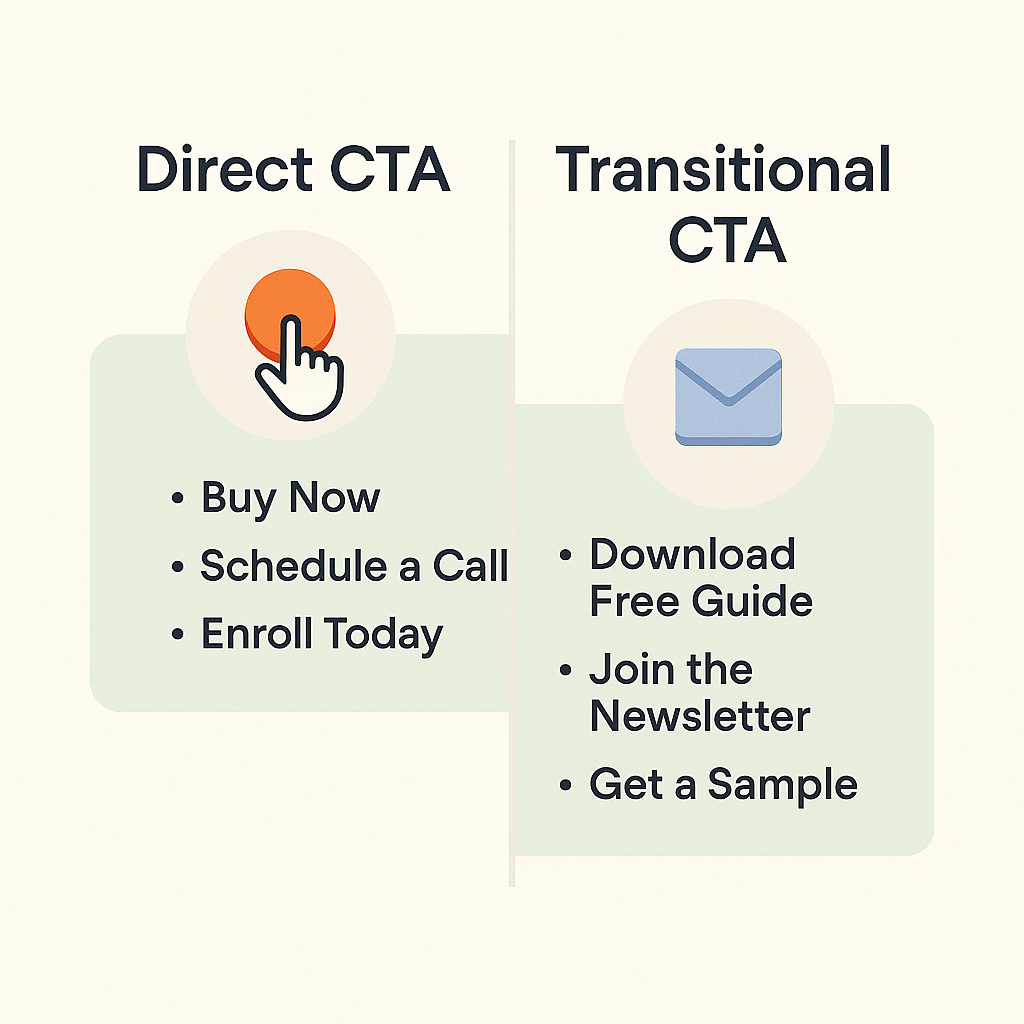
There are two types of calls to action:
- Direct Call to Action: This is the straightforward “Buy Now,” “Call Today,” “Register Here,” kind of CTA. It doesn’t mince words about the fact that you’re asking for their business. Every marketing communication should have an obvious direct CTA somewhere, because if you never ask, the answer is always no. Don’t be shy here – clarity is not pushy, it’s helpful. A button that says “Get Started” or “Schedule an Appointment” is actually user-friendly because it tells people what to do.
- Transitional Call to Action: This is for people who aren’t ready to jump into a paid relationship yet. It offers a risk-free way to engage further – like a free ebook, a webinar, a sample, a trial, or even just more information. It’s called “transitional” because it bridges the gap between total stranger and customer. For example, “Download our free guide to X,” or “Take our 5-day email course,” or “Get a free consultation.” Transitional CTAs are powerful for building your pipeline. They allow you to demonstrate value, build trust (reciprocity: you gave them something), and nurture the relationship until they’re ready to commit.
For long-term growth, transitional calls to action often work better than going for the hard sell immediately. They accomplish a few things:
- Establish Authority & Empathy Further: By offering helpful content up front, you stake a claim in your domain. You show what you stand for and what expertise you bring, without asking for anything (except maybe an email address) in return. This positions you even more as the guide.
- Create Reciprocity: Human psychology 101 – when someone gives us something of value, we have a natural inclination to give back. If your free checklist saves me 5 hours of work, I’m now much more interested in hearing your pitch, or even buying your product down the line, because you’ve proven your value.
- Clarify Your Message: Good transitional content also reinforces your main message in a low-pressure way. It’s like a showcase of how you solve problems. By the end of consuming it, the customer should be even more convinced that you understand them and have a solution.
Whether direct or transitional, your calls to action must be clear and prominent. Don’t bury the ask. People are drawn to clarity, not confusion, and they actually appreciate when you make the next step obvious. It shouldn’t feel like a guessing game to find out how to buy from you or how to learn more.
A quick audit you can do: look at your website’s homepage or a recent ad. Can a viewer spot what you want them to do in less than a second? If not, make that button bigger, brighter, or more to the point.
Sometimes I see websites with clever phrases like “Discover the Difference” on their buttons – which sounds nice, but is it as clear as “Shop Now” or “Request a Quote”? Be wary of sacrificing clarity for creativity at this critical juncture. Keep it simple and direct.
6. That Helps Them Avoid Failure (Stakes)
Finally, let’s talk about stakes. Every human being on this planet is trying to avoid a tragic ending, aren’t we? In story terms, this is the part where we remind the audience what could happen if the hero doesn’t take action – the failure that looms.
A story without the risk of failure has no tension (and is pretty boring). Likewise, a marketing message that only talks about benefits without addressing the potential loss or downside of not acting can fall flat. People do pay attention to what they might lose.
Psychologist Daniel Kahneman’s research on loss aversion demonstrates that people are often more motivated by avoiding loss than by achieving gain. In fact, the pain of losing is about twice as powerful as the pleasure of gaining. Put simply, most of us hate losing $100 more than we enjoy winning $100. We’re wired that way.
So, while it’s important to paint the positive picture (success, which we’ll do next), it’s equally important to candidly point out the cost of not doing business with you – the loss they might experience if they don’t solve their problem.
This isn’t about scare tactics or being manipulative; it’s about being honest that there are consequences to inaction.
Here are some ways to ethically leverage this principle of stakes/avoiding failure:
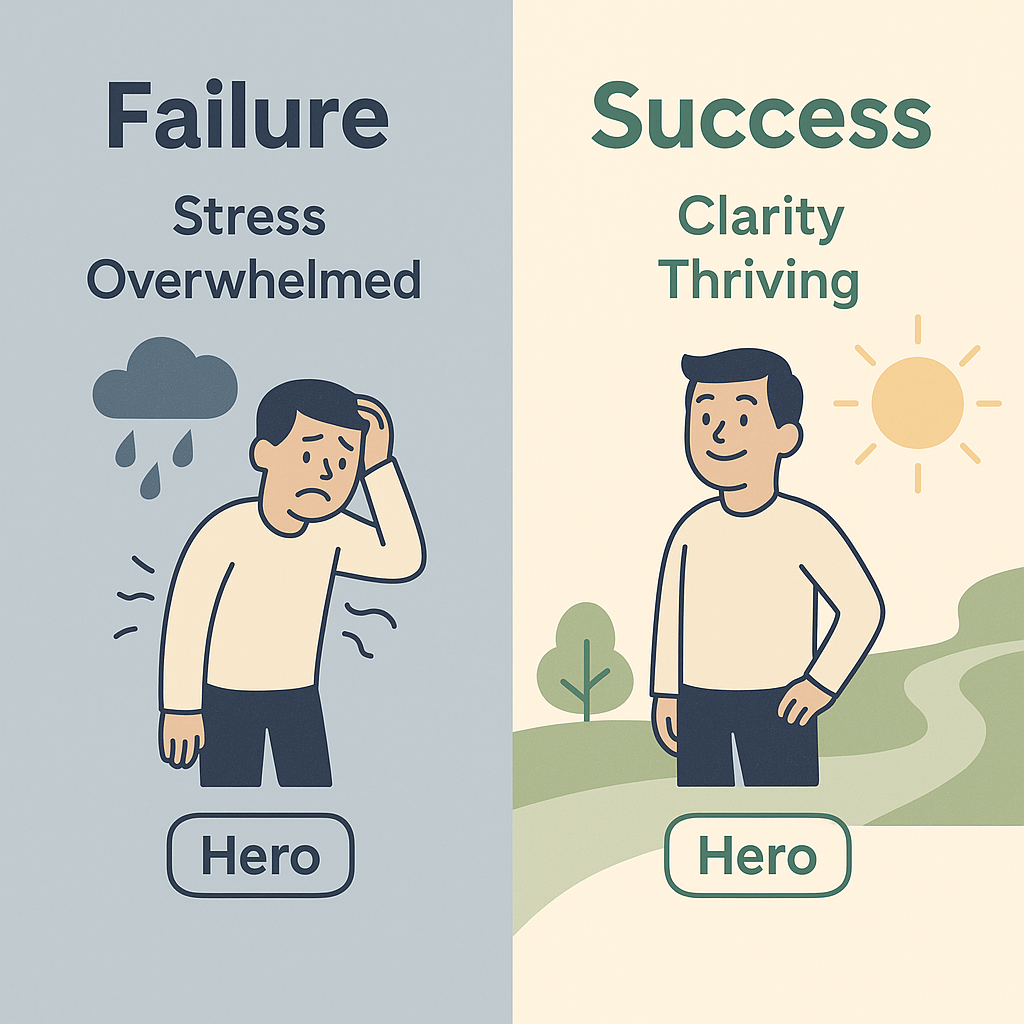
- Highlight a Vulnerability: Help readers see that there is a real risk or threat out there. For example, a home security company might say, “Did you know most burglars strike in the first 10 minutes when they see no alarm system?” Or a financial advisor might point out, “Without a retirement plan, you could outlive your savings.” In our termite control example, one might note, “Nearly 1 in 3 homes shows signs of termite damage – most owners don’t realize until it’s too late.” The key is to raise a relevant concern that the customer might not be fully aware of.
- Show the Consequence of Ignoring It: Now that you’ve opened their eyes to a risk, let them know what happens if they do nothing. “Those termites won’t go away on their own – they’ll chew through your equity and leave you with a massive repair bill.” Or “Every month without an investment plan is a month closer to retirement with less money to live on.” Make it tangible. We often avoid thinking about bad outcomes; your job is to (gently) make it real enough that they can’t just push it aside.
- Offer the Antidote (Your Solution): Immediately after presenting the risk, you offer hope. “Fortunately, our complete home treatment can eliminate termites and guarantee your home stays pest-free (with a one-year warranty for peace of mind).” Notice how that both presents the solution and reassures (warranty = you won’t lose). Or “Our retirement planning service will ensure you never run out of money, no matter how long you live.” You want to contrast the dark alternative with the bright alternative – and your product is the bridge to the bright side.
- Add Credibility: If people are going to trust that your solution truly averts the failure, back it up. Mention your expertise (“With 10+ years of experience, we’ve seen it all”), your proven track record (“hundreds of homes saved” or “our clients retire with an average of 20% more income”), and any social proof (“see testimonials from people we’ve helped”). This isn’t the time for modesty – it’s the time to assure them they’re in safe hands if they choose you.
- Include a Customer Story or Testimonial: This can be powerful. E.g., “Sarah K. noticed something odd in her basement but ignored it. By the time we inspected, termites had caused $8,000 in damage. Don’t be like Sarah – our early intervention saved the Jones family from that fate when they called us in time.” Or for a positive spin, “One customer said, ‘I sleep better knowing my family is protected.’” Real stories stick with people. They create an emotional urgency beyond raw facts.
- Create Urgency (Gently): Finally, prod them to act now. “Call us today to schedule your home inspection before minor issues turn into major damage. (Our schedule fills up fast, so don’t wait!).” You don’t have to do the cheesy “Act now, only 2 left!” unless it’s genuine. But do remind them that time is a factor. There is a cost to waiting – even if it’s just more days feeling stressed, or risk accumulating.
Let me pause a second to thank you, dear reader. You’ve come a long way with me in this article (most people with shorter attention spans have probably already checked out some cat videos or something). I appreciate you sticking around! 🙏 (Alright, end of interruption – back to the story. 😉)
The point is, don’t shy away from describing the potential failure. If your product truly helps avoid a loss, it’s your duty to mention that loss. It injects crucial energy into your story. Just remember to do it ethically (we’re here to help them, not just scare them).
By identifying what’s at stake – what your customer stands to lose if they ignore the problem – you activate a powerful motivator. You help them realize that doing nothing is not a safe option, and that buying your product or service is the path to safety or relief.
7. And Ends in Success (The Happy Ending)
We’ve established the hero (customer) wants something, faces problems (villains), finds a guide (you) with a plan, is called to action, and knows the stakes of failure. Now it’s time for the part every story needs: a vision of success. This is where you paint the picture of how much better your customer’s life can be if they win – with your help.
Never assume people automatically understand how your brand will change their lives. Spell it out for them. If they use your product or service, what is the specific, positive outcome they can expect? Where is the destination you’re guiding them to?
A common mistake in marketing is staying too vague about success. We say things like “Achieve your dreams” or “Improve your life” – which sound nice, but don’t actually create a mental movie for the customer. Instead, describe success in vivid, concrete terms:
- If you’re a financial planner, success might be: “You’ll retire comfortably, traveling the world, without ever worrying about money.”
- If you sell an eco-friendly water bottle, success could be: “You stay hydrated all day, save money on plastic bottles, and feel great knowing you’re helping the planet.”
- If you’re a career coach, success could be: “Land a job you love, with a salary you deserve, and wake up excited every Monday.”
See the difference? Specificity creates imagery, and imagery creates impact.
Think about the transformation your customer will experience. What will they have more of? (More time, money, peace, confidence, health, status?) What will they have less of? (Less stress, fear, waste, loneliness, pain?) Include those elements in your success picture.
Also, success is often tied back to resolving the internal problem we identified earlier. If the internal struggle was feeling overwhelmed, success might be “feeling in control and confident each day.” If it was feeling unsafe, success might be “feeling secure and at peace in your home every night.” We want to show that not only is the external problem fixed, but the internal wound is healed.
And if you touched a philosophical point, show that the “good” won: justice was served, values upheld (e.g., “by switching to our solution, you’ll know you’re doing your part to create a sustainable future”).
Let’s revisit our hero’s journey one last time: When the customer uses your product, they (the hero) either overcome something or gain something. Don’t be shy in celebrating that.
You want them to almost feel that relief or triumph just by reading your copy or listening to your pitch. It should be aspirational yet believable – they should be nodding along thinking, “Yes, that’s what I want for myself.”
Importantly, make success tangible. It can often help to quantify it if possible: “increase your revenue by 30%,” “save 10 hours a week,” “lose 15 pounds in 3 months,” etc., if those numbers are realistic and proven for your offering. Or qualify it with a strong description: “a spotless home that impresses your guests,” “a website that makes competitors jealous,” etc.
One more thing: success should feel achievable. It’s okay to promise big, but if you promise the moon for something that clearly only delivers a car, people might not trust it. Align the scope of success with what you truly deliver, but frame it as the best version of that.
For example, if you’re a local pizza shop, don’t say “This pizza will make you the happiest person on Earth” (hyperbole). Instead, success is “You’ll savor every bite and delight your friends on game night – becoming the go-to house for great pizza.” That’s a realistic happy ending for a pizza purchase: enjoyment and social kudos.
In conclusion, show people the happy ending you’re offering. Guide them to imagine their story after using your product or service: the problem is gone, the villain defeated, the hero triumphant. When customers can clearly see where you’re taking them, they’re much more likely to follow you.
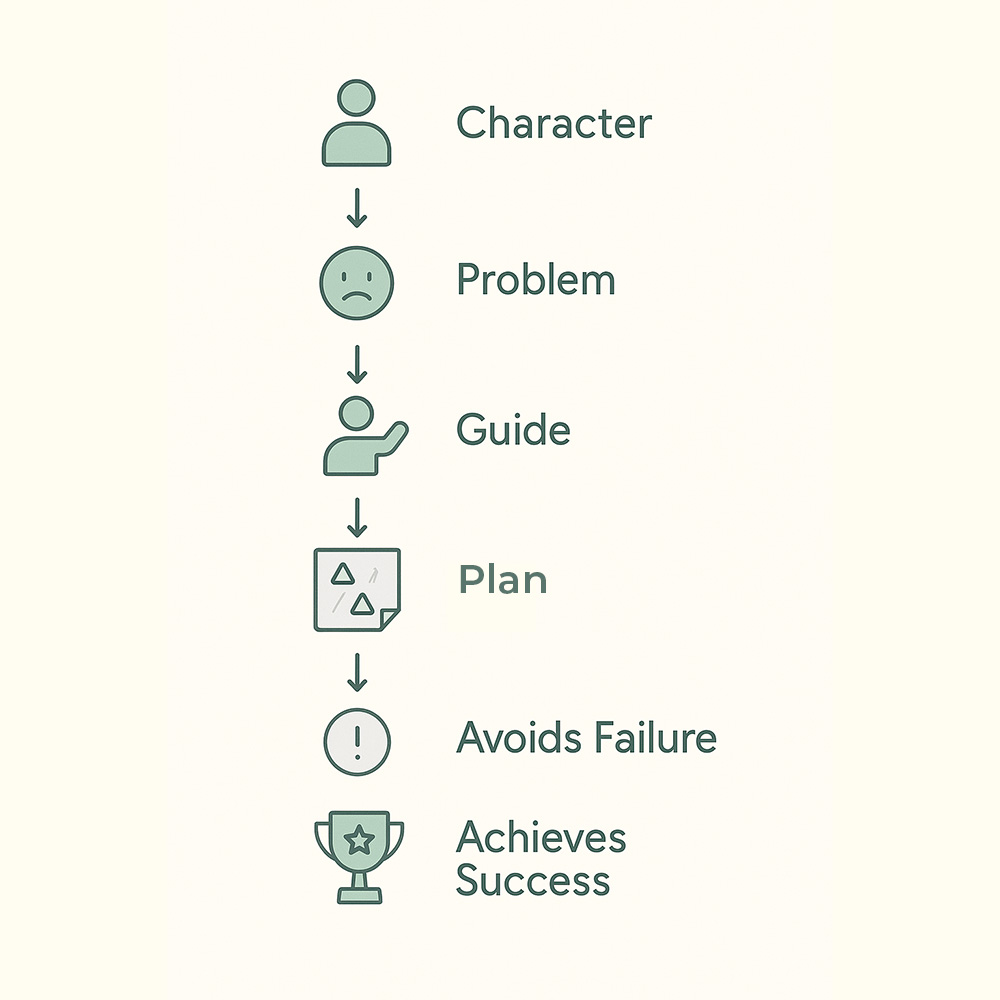
And guess what? If you’ve followed the framework up to this point, the success you describe will feel not like your claim, but like their victory. You have effectively positioned your brand as the guide, and given the customer the role of hero in a story with a very happy ending.
I’m truly excited about the power of story in branding – I could go on and on. But I know this has been a lengthy journey, so I’ll wrap it up here. Now it’s your turn: take these insights and start crafting or refining your own brand’s story. Remember, every line of your messaging should serve the story and provide value to your hero (the customer).
Thank you for reading to the end. 🎉 If you have any questions or feedback, I’d love to hear from you. Go forth and be the guide your customers need – help them be seen, heard, understood, and ultimately, transformed through the story your brand tells. Good luck, and happy storytelling!

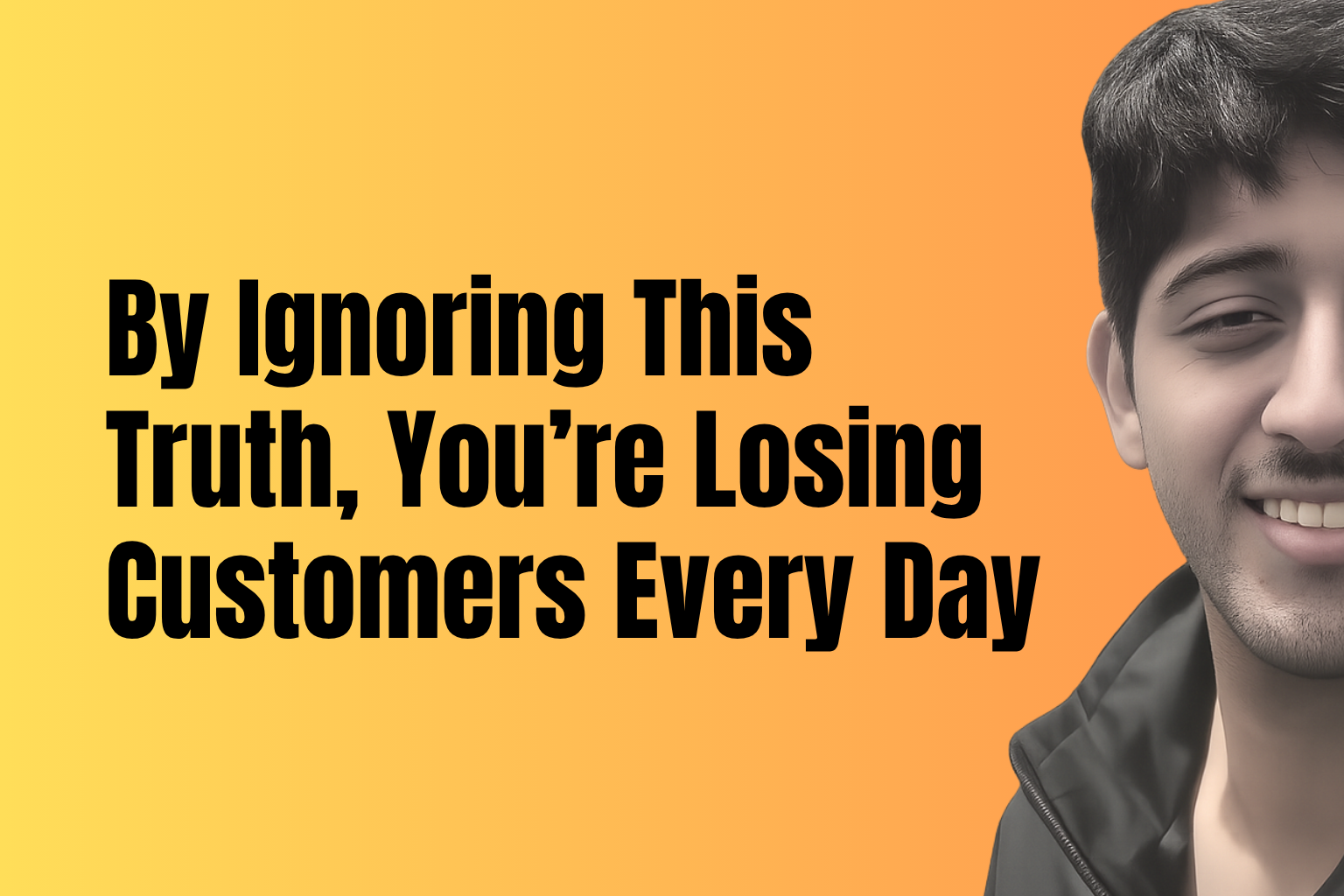
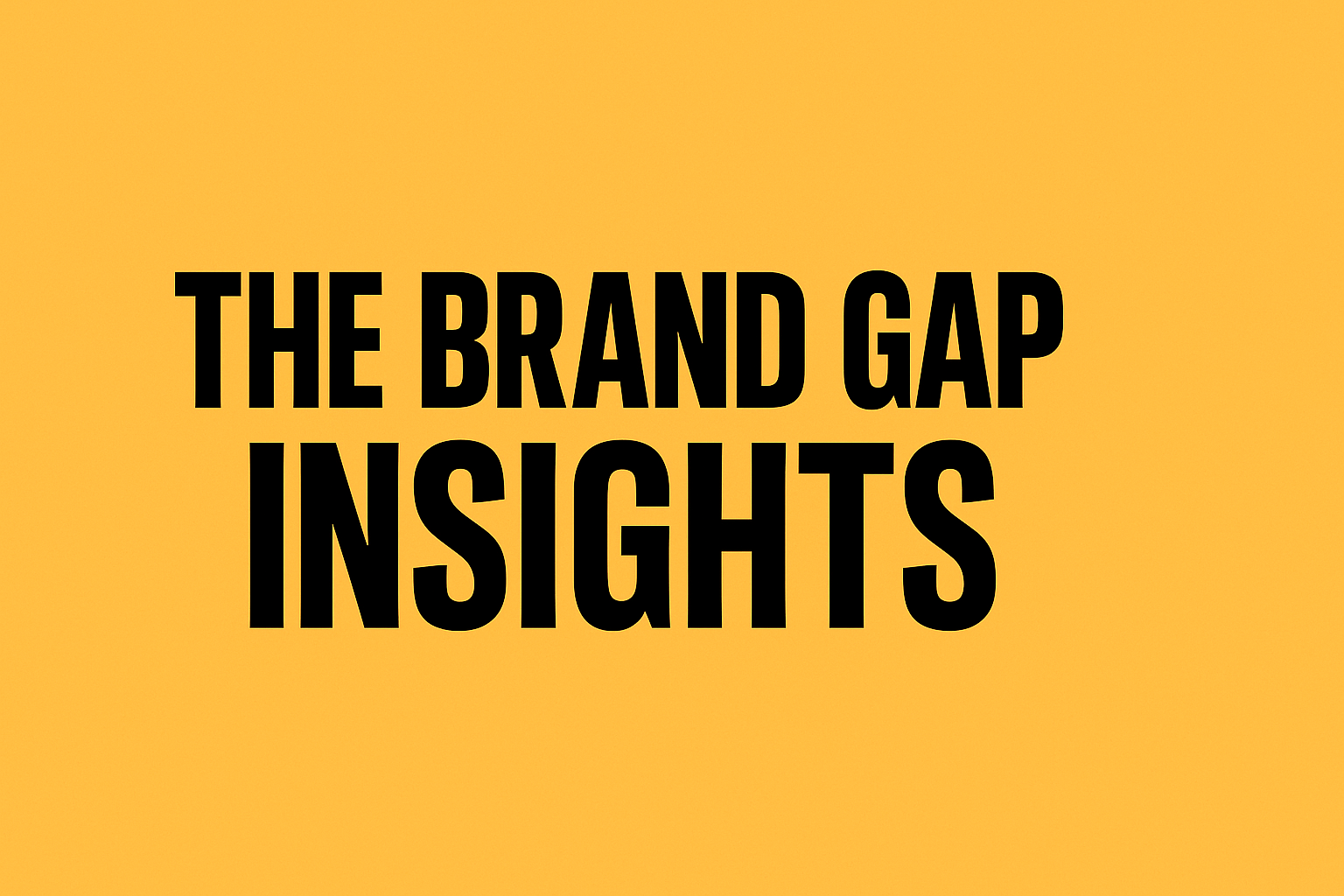

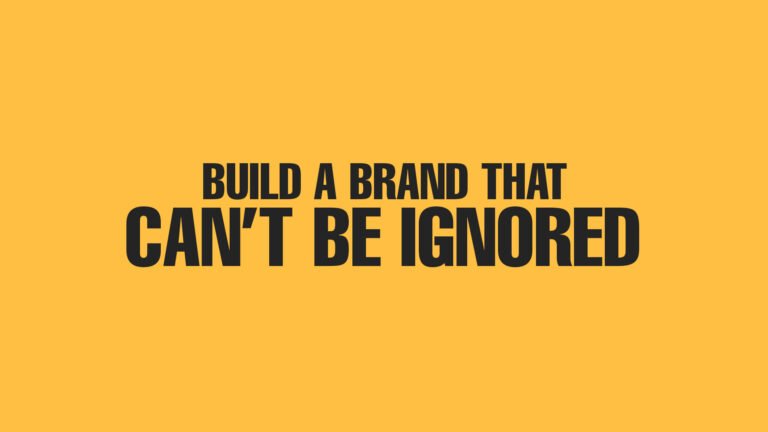
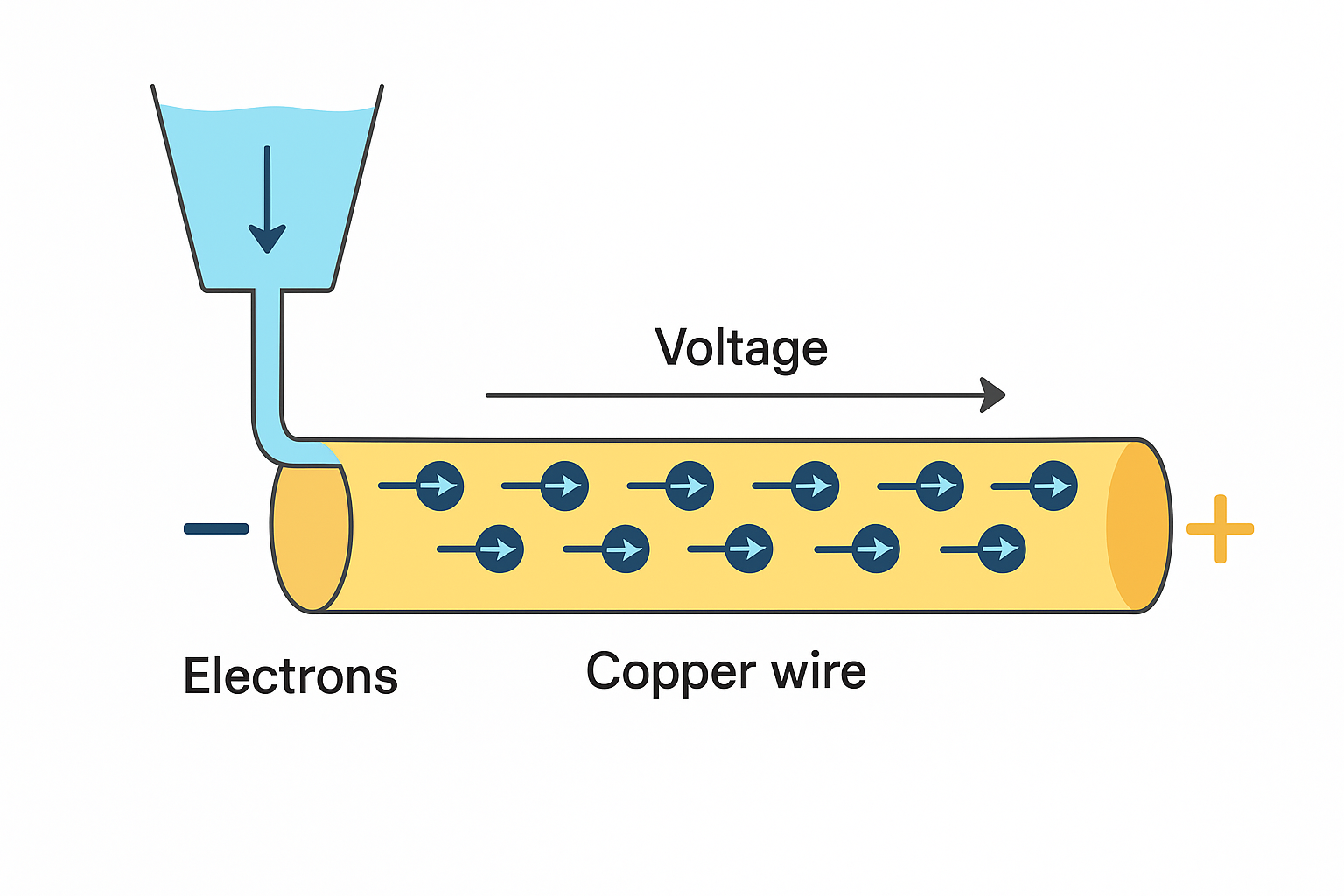

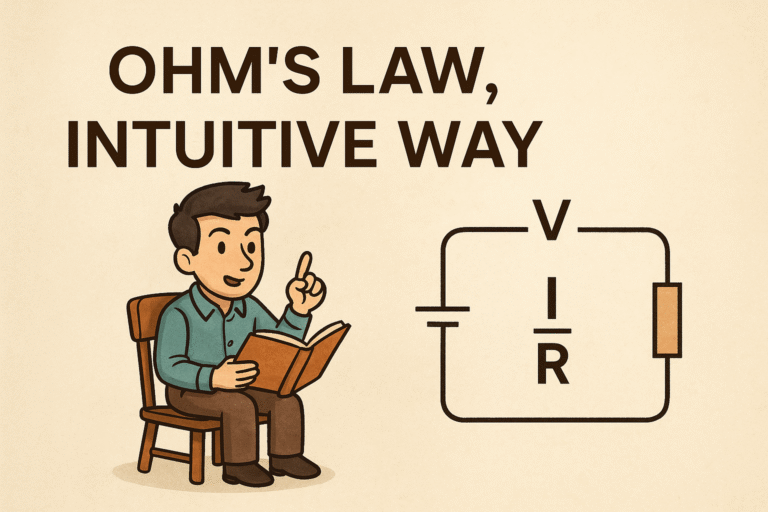
Дизайнерская мебель премиум класса — это воплощение изысканного стиля и безукоризненного качества.
Премиум мебель — это выгодная инвестиция в стиль и комфорт вашего пространства.